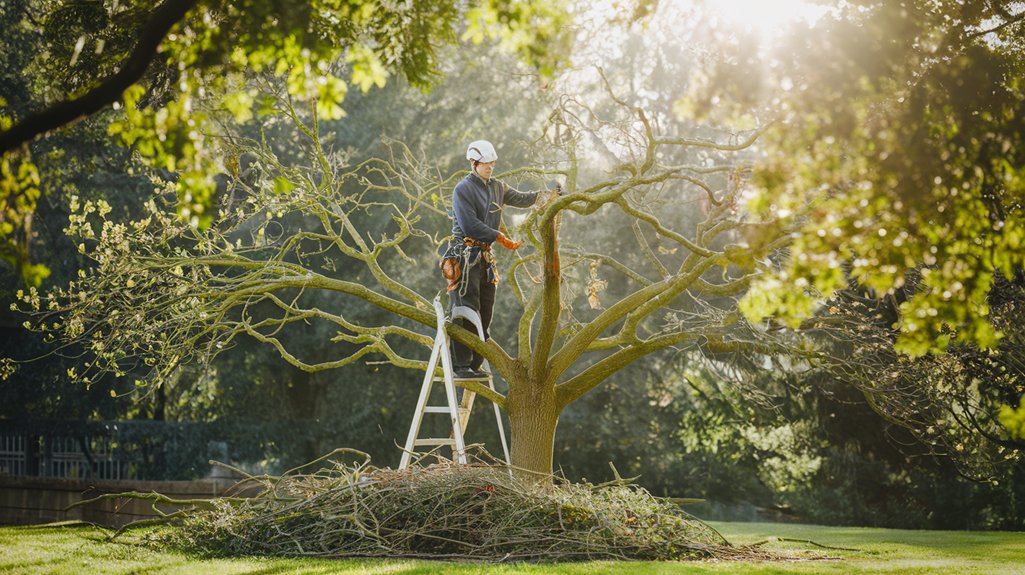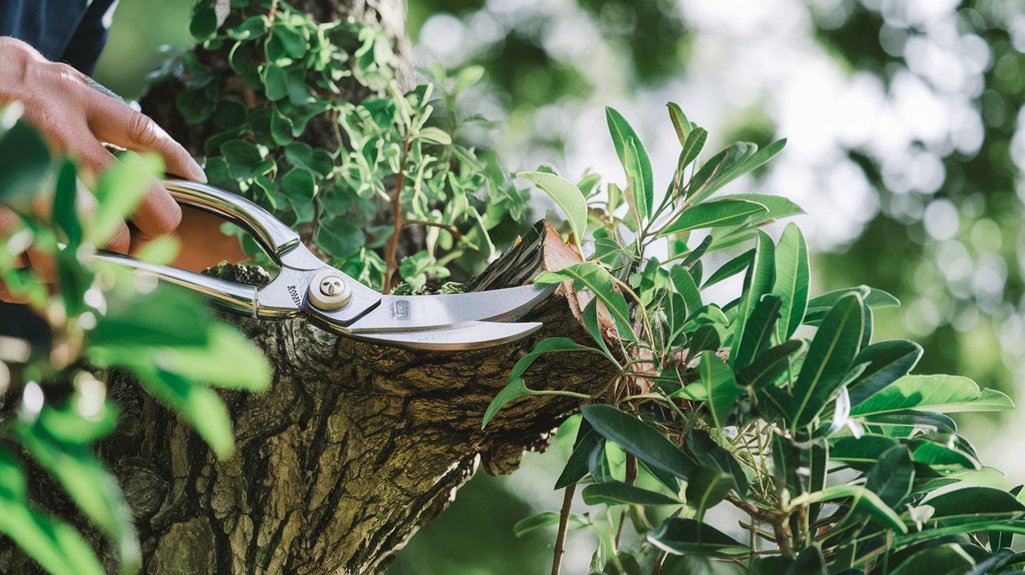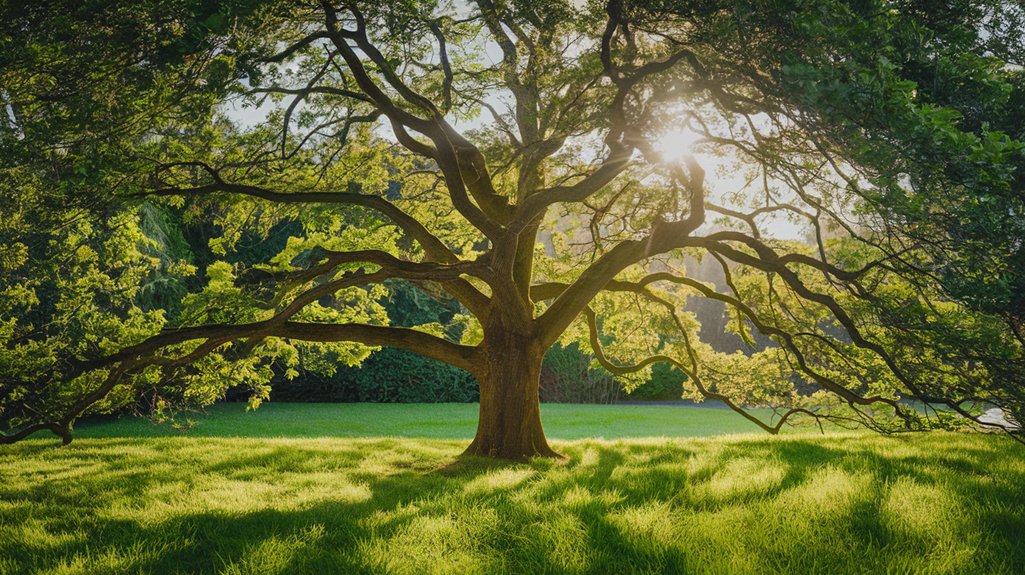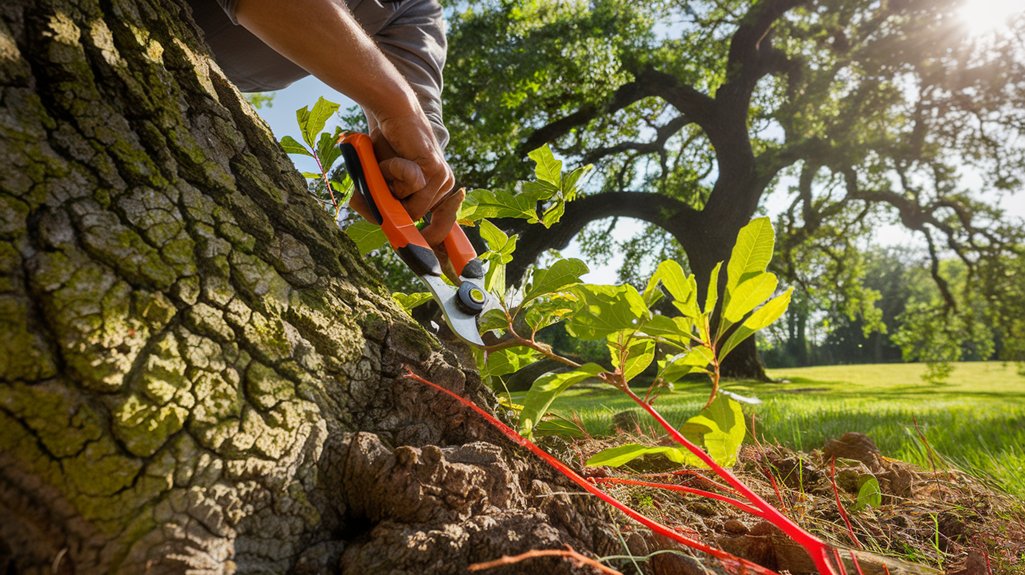When it comes to maintaining your trees, pruning is more than just a routine task—it’s a crucial practice that can transform their health and appearance. By understanding how proper pruning techniques promote growth and prevent disease, you can ensure your trees thrive in any landscape. But what are the specific benefits of pruning, and how can you get it right? Let’s explore the essential reasons why tree pruning matters.
Understanding the Importance of Tree Pruning

When you think about maintaining the health and beauty of your trees, understanding the importance of tree pruning is essential.
Pruning techniques directly impact tree biology, promoting strong growth and optimal structure. By selectively removing branches, you’re enhancing light penetration and air circulation, which are vital for photosynthesis and overall vitality.
Proper pruning allows the tree to allocate resources more efficiently, reducing stress and disease susceptibility. It also helps shape the tree, preventing overcrowding and ensuring it remains aesthetically pleasing.
Knowing when and how to prune can make all the difference. So, take the time to educate yourself on effective pruning methods, and you’ll see your trees thrive like never before.
Tree Pruning Benefits create thriving landscapes. Learn tree care from Colorado State University Extension.
Promoting Healthy Growth Through Pruning

Although you mightn’t realize it, pruning is one of the most effective ways to promote healthy growth in your trees. When you prune correctly, you enhance nutrient distribution throughout the tree, ensuring that the vital resources reach the branches and leaves that need them most. This leads to stronger, more vibrant foliage and improved overall health.
It’s essential to pay attention to seasonal timing, as different trees have specific periods when pruning yields the best results. For instance, late winter or early spring is often ideal for many species, allowing them to heal quickly and thrive.
Enhancing Airflow and Sunlight Penetration

To ensure your trees thrive, enhancing airflow and sunlight penetration is crucial. Proper pruning allows air to circulate freely, and sunlight access promotes healthy growth.
Here are three key airflow benefits to consider:
- Improved Photosynthesis: With increased sunlight access, your trees can produce more energy, leading to vibrant foliage and strong branches.
- Reduced Humidity: Better airflow decreases moisture levels around the leaves, minimizing the risk of mold and other issues.
- Stronger Structure: Pruning helps maintain a balanced shape, allowing wind to pass through without causing damage.
Preventing Disease and Pests
Pruning not only enhances airflow and sunlight penetration but also plays a vital role in preventing disease and pests. By removing dead or infected branches, you minimize the risk of spreading pathogens throughout your trees.
Regular pruning encourages robust growth, allowing your trees to better withstand diseases that can weaken their structure.
Additionally, proper pest management becomes easier when you maintain your trees. When you keep branches well-trimmed, you reduce hiding spots for pests and make it simpler to spot any infestations early on.
This proactive approach helps you catch problems before they escalate, ensuring your trees remain healthy and vibrant.
Ultimately, smart pruning practices will protect your trees and enhance their longevity.
Shaping Your Trees for Aesthetic Appeal
When you shape your trees for aesthetic appeal, you’re not just enhancing their beauty; you’re also creating a harmonious landscape that complements your home.
Artistic trimming helps achieve visual balance, making your outdoor space more inviting. Here are three tips to guide you:
- Assess the Tree’s Shape: Look for natural growth patterns and decide on a shape that enhances its form.
- Trim Strategically: Remove excess branches to create an open canopy, allowing light to filter through while maintaining a balanced silhouette.
- Consider Surroundings: Ensure your trees harmonize with nearby plants and structures, enhancing the overall visual appeal of your landscape.
Safety Considerations: Reducing Hazards
While enhancing your landscape’s beauty is important, safety should always come first. Before you start pruning, conduct a thorough hazard assessment. Look for potential risks like dead branches, power lines, or uneven ground that could pose dangers during your work.
Wearing appropriate safety gear is essential. Invest in gloves, goggles, and a hard hat to protect yourself from flying debris or falling branches.
If you’re using power tools, make sure you have ear protection and sturdy footwear.
Best Practices for Effective Tree Pruning
To achieve optimal results in tree pruning, understanding the right techniques is crucial. Using proper timing techniques and the right pruning tools can make a significant difference in your tree’s health and appearance.
Here are three best practices to follow:
- Prune at the Right Time: Early spring or late winter is ideal for most trees, as it encourages healthy growth.
- Use Sharp Tools: Invest in quality pruning tools, like bypass pruners and loppers, to ensure clean cuts that heal quickly.
- Follow the 1/3 Rule: Never remove more than one-third of a tree’s canopy in a single session to prevent shock and promote steady growth.
Frequently Asked Questions
How Often Should I Prune My Trees?
You should prune your trees annually for optimal growth, but some species may benefit from biannual pruning. Adjust your pruning frequency based on tree health, age, and specific growth patterns to ensure strong, beautiful trees.
Can I Prune Trees During Any Season?
You can prune trees in various seasons, but seasonal pruning typically depends on tree growth. Early spring and late winter are best for many species, while summer pruning can help control growth and shape.
What Tools Do I Need for Pruning?
For effective pruning, you’ll need pruning shears for small branches, loppers for thicker ones, and saw options for larger limbs. Don’t forget your safety gear to protect yourself while working on those trees!
How Do I Know if a Tree Needs Pruning?
To know if your tree needs pruning, look for signs of tree health decline, like dead branches, crowded growth, or disease. If you spot these issues, it’s time to consider pruning for better vitality.
Are There Specific Techniques for Different Tree Species?
Yes, there are species-specific techniques for pruning. You should research each tree type to determine the best methods and pruning timing, ensuring you promote healthy growth while maintaining the tree’s natural shape and structure.
In conclusion, tree pruning is crucial for keeping your trees healthy, strong, and beautiful. By regularly trimming and shaping your trees, you promote better growth, enhance airflow, and reduce the risk of disease and pests. Plus, a well-pruned tree adds aesthetic value to your landscape. Remember, safety is key during pruning, so follow best practices to avoid hazards. Embrace the art of pruning, and watch your trees thrive in a vibrant ecosystem!
Contact Us
Tree Pruning Benefits with Above & Beyond Services keep your Denver trees healthy and beautiful. Call (720) 806-6378 or visit Above & Beyond Services for free quotes on tree care, pest control, and more.
Key Takeaways
- Pruning enhances tree biology, promoting strong growth and improved overall health through better nutrient distribution.
- It increases light penetration and airflow, which boosts photosynthesis and reduces humidity-related issues.
- Regular pruning helps prevent disease by removing dead or infected branches, minimizing pathogen spread.
- Proper techniques shape trees aesthetically while preventing overcrowding and maintaining structural integrity.
- Seasonal timing, ideally in late winter or early spring, supports quick healing and thriving growth post-pruning.




